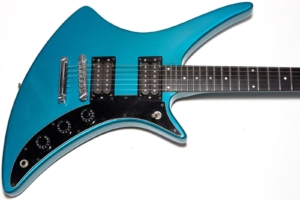 As of this writing the year is 2018. This guitar is from 1982 which makes this guitar 36 years old. Finding a 36-year old guitar in mint condition is no easy feat, and it took me years to find this Guild X79 Skyhawk guitar in this beautiful unfaded metallic blue finish. That’s partly crazy because this was a very popular model for Guild, but it’s also partly not surprising for reasons that will become clear in my review.
As of this writing the year is 2018. This guitar is from 1982 which makes this guitar 36 years old. Finding a 36-year old guitar in mint condition is no easy feat, and it took me years to find this Guild X79 Skyhawk guitar in this beautiful unfaded metallic blue finish. That’s partly crazy because this was a very popular model for Guild, but it’s also partly not surprising for reasons that will become clear in my review.
Let’s see how this guitar holds up when viewed through the eyes of someone who really enjoyed the ’80s.
Introduction
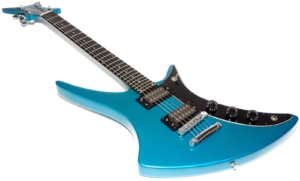 This guitar may look like a goofy one-off from the 1980s, but it was actually a pretty popular model for Guild. First introduced in 1981 or so, they stayed in the Guild line-up until 1985 with a total of almost 1800 guitars produced. That figure is according to the often incorrect Guild Serial Number Chart but we’ll get back to that in a minute.
This guitar may look like a goofy one-off from the 1980s, but it was actually a pretty popular model for Guild. First introduced in 1981 or so, they stayed in the Guild line-up until 1985 with a total of almost 1800 guitars produced. That figure is according to the often incorrect Guild Serial Number Chart but we’ll get back to that in a minute.
Guild had introduced a very non-traditional body shape a few years earlier with the New Guild shape seen on guitars like the S300 and the S60. A lot of people think that shape was ugly and, though they were fantastic guitars, the shape didn’t really stir any major artists into accepting them. The X79, though, with its more graceful lines and introduction at a time when the rock world was looking for new and exciting (and often Day-Glo) things seems to have had more of an impact.
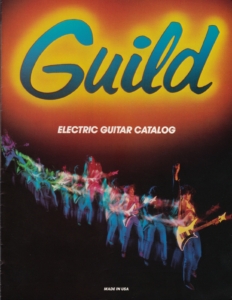 Guild seemed to have really taken this new body shape seriously because it was not only on the forefront of the 1982 catalog, but it was also on the cover art for the Ax-cessories catalog from the same year. The older Ax-cessories catalog showed a transparent Guild S300 which I always thought was cool as hell, even if it didn’t seem to have any wiring in the body. The X79 shape is seen all over Guild’s marketing material from the time, and along with the X82, seemed to be a driving force for the new line of guitars, all of which would sport names of famous airplanes thanks to a fascination for piloting and aircraft that was shared by some of the company’s founders. The X79 Skyhawk was likely named for the Douglas A4 Skyhawk or the McDonnell Douglas A4G Skyhawk. Or, you know, maybe both.
Guild seemed to have really taken this new body shape seriously because it was not only on the forefront of the 1982 catalog, but it was also on the cover art for the Ax-cessories catalog from the same year. The older Ax-cessories catalog showed a transparent Guild S300 which I always thought was cool as hell, even if it didn’t seem to have any wiring in the body. The X79 shape is seen all over Guild’s marketing material from the time, and along with the X82, seemed to be a driving force for the new line of guitars, all of which would sport names of famous airplanes thanks to a fascination for piloting and aircraft that was shared by some of the company’s founders. The X79 Skyhawk was likely named for the Douglas A4 Skyhawk or the McDonnell Douglas A4G Skyhawk. Or, you know, maybe both.
I see people referring to Guild X79s as rare a lot on line. They’re not – at least not by Guild production number standards. I see people saying that there were less than 200 made a lot, too. According to this post by Hans Moust, 1790 of them were “officially produced” with the majority having been numbered in 1982 which, according to that post, is the year that this guitar was made. Note that the serial number list that Guild has on their website is wrong and Hans’ post on LetsTalkGuild.com should be used as reference for all of your Guild X79 research needs.
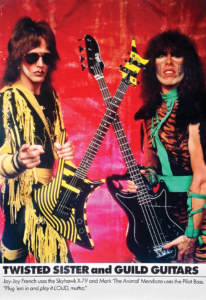 I also find it amusing how many ads I find for the “rare” black sparkle finish. The colors listed in the early catalog include Sunburst, Candy Apple Red, Black, Metallic Blue, Black Sparkle, and Purple. The colors I see most often are Candy Apple Red and Black Sparkle which is why it’s funny to me that so many people think it rare. Note that if you see one in Metallic Green or Aqua Green the guitar was probably Metallic Blue like the one in this review and the yellowing clear-coat has made it green over time. See this thread from LetsTalkGuild.com for an example and discussion about blue/green X79s. I’ve only seen one purple one over the years but the owner backed out at the last minute and wouldn’t sell it to me. I can’t really blame him, though; that guitar was even prettier than the blue one currently in my hands.
I also find it amusing how many ads I find for the “rare” black sparkle finish. The colors listed in the early catalog include Sunburst, Candy Apple Red, Black, Metallic Blue, Black Sparkle, and Purple. The colors I see most often are Candy Apple Red and Black Sparkle which is why it’s funny to me that so many people think it rare. Note that if you see one in Metallic Green or Aqua Green the guitar was probably Metallic Blue like the one in this review and the yellowing clear-coat has made it green over time. See this thread from LetsTalkGuild.com for an example and discussion about blue/green X79s. I’ve only seen one purple one over the years but the owner backed out at the last minute and wouldn’t sell it to me. I can’t really blame him, though; that guitar was even prettier than the blue one currently in my hands.
If the custom print designs like the yellow and white striped one in the Twisted Sister ad make you shake your head and wonder why such a design could get greenlit, consider that these guitars were being sold in the early to mid 1980s when bands like Twisted Sister with all the big hair, dangling jewelry, makeup, fluorescent spandex and torn… whatever it is that they’re wearing… were insanely popular. If you have trouble believing that statement, remember that I lived it and I’m here to tell you that dressing like that was pretty typical for a hair-metal band in the ’80s. If you still don’t believe me, look for yourself and read up on bands like Ratt, Poison, Cinderella, Mötley Crüe, and Stryper, just to name a few. It was a hell of a time to be a heterosexual male thinking that it was all cool as hell, and it was cool as hell because all the hot hair-band-loving girls loved it.
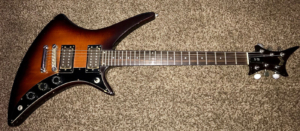 Custom colors including Crystal red, blue, and black grain were availble for a $50 upcharge, while graphics such as the yellow and black striped model being held by Jay-Jay French in the ad above were available for an additional $100-250 (these numbers likely changed according to the year or production). If you’d like to see a legitmately rare finish, check out this sunburst example that I found on Reverb. Such a traditional finish on such a futuristic guitar is pretty wild and I think must have been a custom order.
Custom colors including Crystal red, blue, and black grain were availble for a $50 upcharge, while graphics such as the yellow and black striped model being held by Jay-Jay French in the ad above were available for an additional $100-250 (these numbers likely changed according to the year or production). If you’d like to see a legitmately rare finish, check out this sunburst example that I found on Reverb. Such a traditional finish on such a futuristic guitar is pretty wild and I think must have been a custom order.
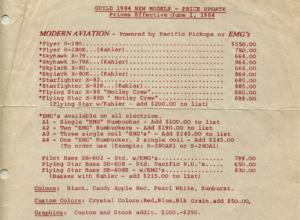 In the 1980s Twisted Sister became quite the endorser for Guild and there are ads like the one shown here found throughout guitar magazines of the period. Whether that was beneficial or baneful to Guild’s chance of selling the X79s is anybody’s guess, but Twisted Sister was pretty big at the time with their faces and garish wardrobes plastered over the still relatively new MTV, so my guess is that it didn’t hurt. I was actually surprised to see how many old Twisted Sister videos featured Guild guitars, a fact that surprisingly escaped me at the time, most likely because I was too busy
In the 1980s Twisted Sister became quite the endorser for Guild and there are ads like the one shown here found throughout guitar magazines of the period. Whether that was beneficial or baneful to Guild’s chance of selling the X79s is anybody’s guess, but Twisted Sister was pretty big at the time with their faces and garish wardrobes plastered over the still relatively new MTV, so my guess is that it didn’t hurt. I was actually surprised to see how many old Twisted Sister videos featured Guild guitars, a fact that surprisingly escaped me at the time, most likely because I was too busy trying not to get kicked out of my apartment for non-payment of rent chasing girls. Hey, I was 18 and living alone in 1982 when this guitar came out. What were you doing when you were an 18 year old guitar player with no money? That’s what I thought.
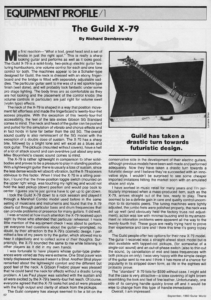 The X79 got a pretty favorable review in the September 1982 issue of Guitar World (shown to the right) with the author, Richard Dembrowsky, stating that, Overall, I am impressed. He also tells about bringing the then radically new X79 to rehearsal and how it garnered a lot of attention. Remember, this was 1982 and the hair band thing was just getting off the ground. Eddie Van Halen had ushered in the era of the Super Strat only a few years earlier when the album Van Halen was released in 1978. Before that the world was pretty much Teles, Strats, Les Pauls and SGs, at least in the realm of rock solid-body guitars. The X79 was clearly something new in an age when people were clamoring for something different.
The X79 got a pretty favorable review in the September 1982 issue of Guitar World (shown to the right) with the author, Richard Dembrowsky, stating that, Overall, I am impressed. He also tells about bringing the then radically new X79 to rehearsal and how it garnered a lot of attention. Remember, this was 1982 and the hair band thing was just getting off the ground. Eddie Van Halen had ushered in the era of the Super Strat only a few years earlier when the album Van Halen was released in 1978. Before that the world was pretty much Teles, Strats, Les Pauls and SGs, at least in the realm of rock solid-body guitars. The X79 was clearly something new in an age when people were clamoring for something different.
I’d say the Guild X79 Skyhawk delivered something different, all right. In fact, I’d say that if there’s one thing the X79 does really well it’s that it doesn’t really fit into anyone else’s mold. It is its own thing which is a pretty rare commodity in the guitar world. Actually, there are plenty of unique guitars out there. I think what’s actually the rare commodity is a unique take on the instrument that actually gets accepted by the masses and sells well. That seems to have been the case for the Guild X79 and its derivatives.
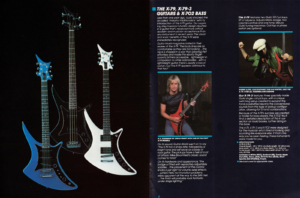 The X79 came is two major variations; the X79 with two humbuckers, and the X79-3 with three single coil pickups. Guild also released a matching X702 bass that shared the same body shape. Options included the phase switch and coil tap on the X79 which also included a traditional 3-way toggle for pickup selection. The X79-3 came with three mini-toggles for a variety of pickup selection choices.
The X79 came is two major variations; the X79 with two humbuckers, and the X79-3 with three single coil pickups. Guild also released a matching X702 bass that shared the same body shape. Options included the phase switch and coil tap on the X79 which also included a traditional 3-way toggle for pickup selection. The X79-3 came with three mini-toggles for a variety of pickup selection choices.
A Kahler bridge was an option for the X79 which was then called an X79K according to the price lists, and the Kahler added a whopping $200 to the $684 price tag. That’s an almost 30% increase for the added ability to dive-bomb with aplomb, and given the time frame in which this guitar was sold, I’m surprised at how many non-Kahler examples I see for sale.
The case
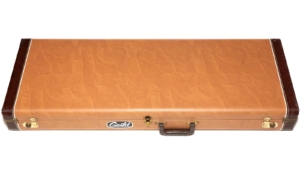 I was floored when I got this guitar because the case is mint. Guild cases often show a lot of wear, my assumption being because the guitars are fantastic and they got played. The ’80s cases seem to have a little bit less resilient skin than your typical tolex case so, though I’ve seen many ’80s Guild cases, this is the first one I’ve seen in this condition. It’s also the first I’ve seen with a Guild sticker instead of a Guild badge.
I was floored when I got this guitar because the case is mint. Guild cases often show a lot of wear, my assumption being because the guitars are fantastic and they got played. The ’80s cases seem to have a little bit less resilient skin than your typical tolex case so, though I’ve seen many ’80s Guild cases, this is the first one I’ve seen in this condition. It’s also the first I’ve seen with a Guild sticker instead of a Guild badge.
Finish
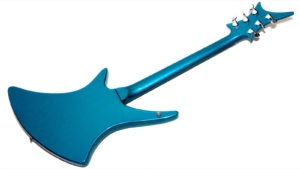 The finish on this guitar is beautiful, but I can say with some certainty that this is because the guitar sat unplayed for so many years. Most of the X79s I see for sale suffer from many finish chips with even entire sections of the neck finish flaking off. My X79-3 suffers from this very fate. I have a suspicion that this has a lot to do with the specific color applied (Candy Apple Red seems to be the worst), but I should also point out that I have no real evidence for this statement aside from my observation of guitars listed for sale over the years.
The finish on this guitar is beautiful, but I can say with some certainty that this is because the guitar sat unplayed for so many years. Most of the X79s I see for sale suffer from many finish chips with even entire sections of the neck finish flaking off. My X79-3 suffers from this very fate. I have a suspicion that this has a lot to do with the specific color applied (Candy Apple Red seems to be the worst), but I should also point out that I have no real evidence for this statement aside from my observation of guitars listed for sale over the years.
My first reaction upon handling this guitar was that it was coated in poly, but it glows a revolting snot green under my black light. My Candy Apple Red (CAR) X79-3 has the finish chipping off in very un-lacquer-like ways as do most of the X79s I’ve seen. That may be due to an undercoat used to make the CAR really pop, though. The fact that the blue ones often age to green tells me that there’s a yellowing clear coat on top which leads me back to lacquer. Some poly applications can yellow too, though. Given that this guitar was finished in the early ’80s, I’m going to go with lacquer.
The quality of the finish on this guitar is beautiful, but as I wrote above I’ve seen a lot of X79s with terrible finish chipping, especially on the neck. Another sore point for any of these very pointy guitars are the pointy bits themselves. These guitars usually have finish chips on the extreme points because those points constantly bang into things and the finish just can’t take it. That’s not a problem specific to Guilds, though, as I’ve seen many Jacksons and Charvels with the same problems at the tip of their very pointy headstocks.
Fretboard and Neck
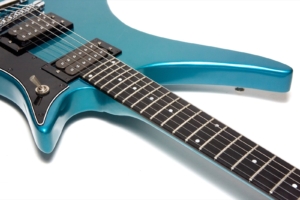 This is a short scale guitar with a 24-fret unbound ebony fretboard. The inlays are simple dots and the frets are .110″ wide by .03″ high making them in the jumbo fret range, though they’re not the kind of jumbos you’d find on a Jackson (my Jackson’s jumbos measure .115″ x .05″ which is a pretty significant difference even though the numbers look pretty close. I say in my X79-3 review that the frets were not jumbos because they measured .105″ x .025″, though looking at this guitar I think that the X-79 had the same frets that had had a fret leveling done.
This is a short scale guitar with a 24-fret unbound ebony fretboard. The inlays are simple dots and the frets are .110″ wide by .03″ high making them in the jumbo fret range, though they’re not the kind of jumbos you’d find on a Jackson (my Jackson’s jumbos measure .115″ x .05″ which is a pretty significant difference even though the numbers look pretty close. I say in my X79-3 review that the frets were not jumbos because they measured .105″ x .025″, though looking at this guitar I think that the X-79 had the same frets that had had a fret leveling done.
As stated, I have both an X79 and an X79-3 and I was surprised to find that the X79 has a deeper neck than the X79-3, though it’s still not what I’d call a fat neck by any stretch of the imagination. The neck is exactly 1 5/8″ wide at the nut and, though better than the X79-3 in my possession, the neck on the X79 fatigues my hand after a while because it’s small and my hands are large.
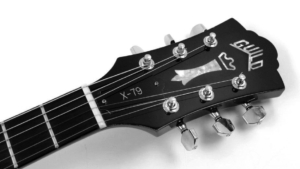 I’ve seen two headstock types on these guitars. The first batches of X79s had traditional Guild headstocks, but most of the ads and catalogs I’ve seen show the wacky pointed headstock like the one on the blue one I’m reviewing. Note that also according to that thread you may see people referring to X79s with the classic Guild headstock as prototypes which is not accurate according to Hans. These early headstocks have the Guild and Chesterfield inlay and headstock veneer like many of the nicer Guild electric guitars from the 1970s which, in my opinion, give the guitar a little more of an elegant feel. That elegant feel is a little bit out of place on the guitar, though, because as much as its a well-made instrument, the traditional headstock makes it kind of like other guitars and this guitar does not want to be like other guitars. That’s actually kind of the point of the whole thing, after all.
I’ve seen two headstock types on these guitars. The first batches of X79s had traditional Guild headstocks, but most of the ads and catalogs I’ve seen show the wacky pointed headstock like the one on the blue one I’m reviewing. Note that also according to that thread you may see people referring to X79s with the classic Guild headstock as prototypes which is not accurate according to Hans. These early headstocks have the Guild and Chesterfield inlay and headstock veneer like many of the nicer Guild electric guitars from the 1970s which, in my opinion, give the guitar a little more of an elegant feel. That elegant feel is a little bit out of place on the guitar, though, because as much as its a well-made instrument, the traditional headstock makes it kind of like other guitars and this guitar does not want to be like other guitars. That’s actually kind of the point of the whole thing, after all.
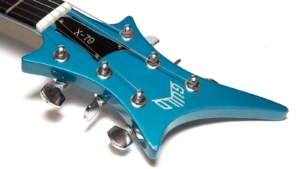 The majority of the X79s I see have the wacky headstock that mirrors the body shape like the one shown here. This headstock has no veneer and the Guild logo resembles the much simpler headtock designs seen on more lower-end Guilds like the D25 acoustic and the S60 electric guitar from the ’70s. That’s not to say that this was a low-priced guitar – it wasn’t. It is a little bit at odds with the ebony fretboard, for example, a feature usually only seen on nicer Guild electric guitars. My guess is that the wacky headstock doesn’t have a veneer because making a veneer in the same shape as that crazy thing would have been complicated and likely cost prohibitive.
The majority of the X79s I see have the wacky headstock that mirrors the body shape like the one shown here. This headstock has no veneer and the Guild logo resembles the much simpler headtock designs seen on more lower-end Guilds like the D25 acoustic and the S60 electric guitar from the ’70s. That’s not to say that this was a low-priced guitar – it wasn’t. It is a little bit at odds with the ebony fretboard, for example, a feature usually only seen on nicer Guild electric guitars. My guess is that the wacky headstock doesn’t have a veneer because making a veneer in the same shape as that crazy thing would have been complicated and likely cost prohibitive.
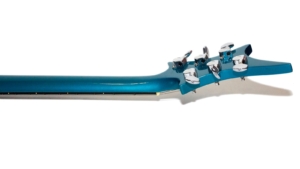 This guitar has a pretty severe headstock angle and when laying the guitar down flat on the ground, the only point of contact is that longest pointy bit at the tip. There are many reasons to always store your guitar in the case, but this is a big one for the X79. This guitar probably wouldn’t sit well in a stand due to the body shape, but if you did manage to get it into one and it fell out, there’s a good chance of a neck break, though you might be saved from catastrophic damage by the long point on the headstock snapping off first. It’s very common to see these guitars on the used market with one or more points snapped off and re-glued.
This guitar has a pretty severe headstock angle and when laying the guitar down flat on the ground, the only point of contact is that longest pointy bit at the tip. There are many reasons to always store your guitar in the case, but this is a big one for the X79. This guitar probably wouldn’t sit well in a stand due to the body shape, but if you did manage to get it into one and it fell out, there’s a good chance of a neck break, though you might be saved from catastrophic damage by the long point on the headstock snapping off first. It’s very common to see these guitars on the used market with one or more points snapped off and re-glued.
Build Quality
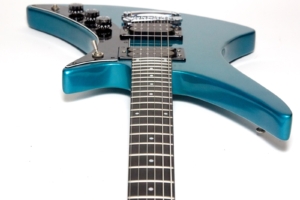 The guitar is so light (6lbs 6oz or 2.9 kilos) that when first picking the guitar up, the impression of quality isn’t necessarily evident. I think that’s a misperception caused by a solid and heavy = good expectation that isn’t necessarily true.
The guitar is so light (6lbs 6oz or 2.9 kilos) that when first picking the guitar up, the impression of quality isn’t necessarily evident. I think that’s a misperception caused by a solid and heavy = good expectation that isn’t necessarily true.
This is a very well-made guitar as are most all Guilds from the Westerly era. The set-neck joint is very solid, the parts are high-quality, and the over all feel is excellent, though it is crazy light. This is also a very small guitar which is certainly part of the reason why it’s so light. In fact, I’d say the guitar is deceptively small. Even when I first pick it up it doesn’t look like it’s as small as it actually is, which is perhaps a trick of perception based on the many long slender lines on the guitar. I think that fact that there is a swooping tail and along extended horn tricks my mind into thinking that the guitar is larger than it is. Because of the odd shape it comes in a standard sized case which further adds to the illusion, though it sits in the case diagonally in order to fit properly.
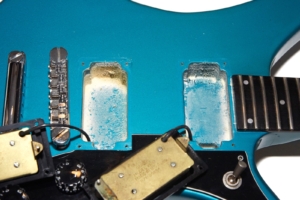 The pick guard is very small and is just large enough to cover the electronics route which is also quite small. There is no binding or purfling anywhere on the guitar. The pickup routes are fairly simple with small holes drilled for the wiring and the pickups are secured to the body with pickup rings.
The pick guard is very small and is just large enough to cover the electronics route which is also quite small. There is no binding or purfling anywhere on the guitar. The pickup routes are fairly simple with small holes drilled for the wiring and the pickups are secured to the body with pickup rings.
The body and neck of these guitars are both mahogany according to both the History of Cool Guitars and the Beesley book (Hans’ book does not cover the ’80s) but it doesn’t looks much like mahogany in any of the cavities. The screw holes do show what appears to be the deeper brownish red of mahogany, though. A recent eBay auction claims to have an unfinished X79 body which is clearly mahogany, but who knows how true the claim of it being a real unfinished Guild guitar are. It could just as well be some talented person’s private project, and without any provenance, there’s no real way to know for sure. I’ve since seen another similarly stripped X79 for sale so I’m going to just accept that these are mahogany guitars and move on.
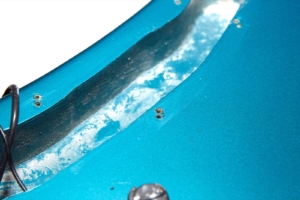 Speaking of screw holes, the only odd aspect of the blue guitar in my possession from a quality perspective is the fact that it looks like the pick guard was put on, removed, then put on again in a slightly different position. there’s no way to tell if this happened before or after it left the factory, but for such an otherwise mint guitar that shows absolutely no signs of having the electronics messed with, I found this discovery to be quite odd. With the pick guard attached you’d never know that this had happened as there are no signs of a problem normally visible. Note that if you zoom into the picture to the right you can see the reddish hue of the wood in the screw holes but you can also see what appears to be a whitish wood which I attribute to the undercoat used to make the finish pop.
Speaking of screw holes, the only odd aspect of the blue guitar in my possession from a quality perspective is the fact that it looks like the pick guard was put on, removed, then put on again in a slightly different position. there’s no way to tell if this happened before or after it left the factory, but for such an otherwise mint guitar that shows absolutely no signs of having the electronics messed with, I found this discovery to be quite odd. With the pick guard attached you’d never know that this had happened as there are no signs of a problem normally visible. Note that if you zoom into the picture to the right you can see the reddish hue of the wood in the screw holes but you can also see what appears to be a whitish wood which I attribute to the undercoat used to make the finish pop.
Pickups
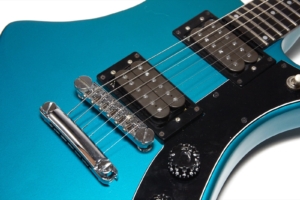 The pickups in this guitar are Guid XR7s made by dimarzio for Guild though these pickups do not say that on the back like some of the earlier ones do. One of the cool things about these is that they can be coil split and phase switched since they have four wires. Both of those were options for the guitar, but this guitar has neither installed, which is a shame because I think it would really add to its versatility. The pickups as they are don’t inspire me much, but given some more tonal options I think the guitar would be a bit more interesting.
The pickups in this guitar are Guid XR7s made by dimarzio for Guild though these pickups do not say that on the back like some of the earlier ones do. One of the cool things about these is that they can be coil split and phase switched since they have four wires. Both of those were options for the guitar, but this guitar has neither installed, which is a shame because I think it would really add to its versatility. The pickups as they are don’t inspire me much, but given some more tonal options I think the guitar would be a bit more interesting.
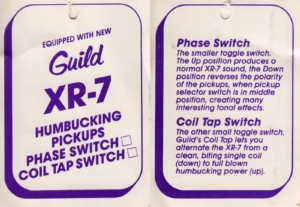 The bridge pickup measures 8.53k and the neck measures 8.34k. One of the cool things about finding such a mint example is that the original hang tag advertising the Guild XR7 pickups was in the case. That hang tag also includes a couple of check boxes along with the description for the phase switch and coil tap options and, no, I won’t go on another rant about how the coil tap feature is actually a coil split (because that’s what it is, dammit). I’ve not personally seen an X79 with both features and thus two mini-toggle switches, but it’s certainly possible to have both in one guitar.
The bridge pickup measures 8.53k and the neck measures 8.34k. One of the cool things about finding such a mint example is that the original hang tag advertising the Guild XR7 pickups was in the case. That hang tag also includes a couple of check boxes along with the description for the phase switch and coil tap options and, no, I won’t go on another rant about how the coil tap feature is actually a coil split (because that’s what it is, dammit). I’ve not personally seen an X79 with both features and thus two mini-toggle switches, but it’s certainly possible to have both in one guitar.
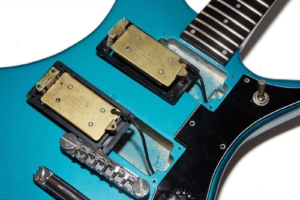 The pickups are a tad too hot for my tastes and I was constantly backing off the volume a bit. That could be resolved by lowering the pickups but I think this guitar would be a lot more fun with a bit more articulation and jangle. To be fair that’s a personal preference thing and I can’t really blame the pickups for that. It was pretty common in the ’80s to have pickups get hotter in order to drive the high gain that had become popular. Unfortunately many of these high-output pickups did so while losing the character that made the sounds of the 1970s so iconic. We were also piping the signal through a rack full of ’80s effects gear back then (more chorus!) so character wasn’t as much of a driving force in pickups as it used to be.
The pickups are a tad too hot for my tastes and I was constantly backing off the volume a bit. That could be resolved by lowering the pickups but I think this guitar would be a lot more fun with a bit more articulation and jangle. To be fair that’s a personal preference thing and I can’t really blame the pickups for that. It was pretty common in the ’80s to have pickups get hotter in order to drive the high gain that had become popular. Unfortunately many of these high-output pickups did so while losing the character that made the sounds of the 1970s so iconic. We were also piping the signal through a rack full of ’80s effects gear back then (more chorus!) so character wasn’t as much of a driving force in pickups as it used to be.
I should point out that XR7s are pretty hit and miss for me, but I’m not sure if I’m hearing differences in versions or if the guitars in question are just built or setup so differently as to make them sound so different.
Electronics
The electronics are very simple in this guitar. There’s a volume knob for the neck pickup, a volume knob for the bridge pickup, and a master tone knob. The master tone knob is after the selector switch in the circuit which is why it applies to whatever pickup is selected.
The electronics route is very tight and I had to forcibly remove the pick guard because the wires had been stuffed into the cavity. The small route made it difficult to put the pick guard back on as well.
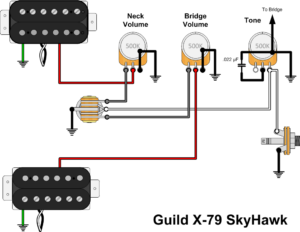 The pickups are decoupled which means that the middle position will allow one of the pickups to be dialed down to zero without muting the guitar.
The pickups are decoupled which means that the middle position will allow one of the pickups to be dialed down to zero without muting the guitar.
On an X79 guitar that includes the phase or coil-split feature, an additional mini toggle switch would be seen mounted between the output jack and tone pot. Be cognizant of this fact when looking at these guitars at your favorite used guitar hunting grounds, because if you see a mini-toggle mounted somewhere else there’s a good chance that it’s not original which means that someone mucked around with the electronics.
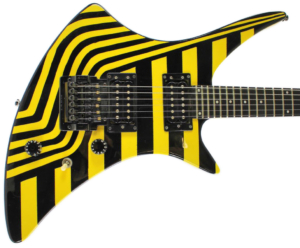 Note that this is not the only control layout seen on X79s. Some of them, like this bumblebee-striped example, have no pick guard on the front opting instead for a control cavity on the back and a completely different control layout. On this X79 (Technically an X79K because of the Kahler) the pickup selector switch has been moved down to the rear of the guitar between the master volume and master tone knobs. This is a good comparison because the similar looking yellow and black striped X79 that Jay Jay French is holding in the Twisted Sister ad in the Introduction has the pick guard and three knobs with the pickup selector near the cutout. It appears to me that the earlier X79s have the pick guard while the later models do not.
Note that this is not the only control layout seen on X79s. Some of them, like this bumblebee-striped example, have no pick guard on the front opting instead for a control cavity on the back and a completely different control layout. On this X79 (Technically an X79K because of the Kahler) the pickup selector switch has been moved down to the rear of the guitar between the master volume and master tone knobs. This is a good comparison because the similar looking yellow and black striped X79 that Jay Jay French is holding in the Twisted Sister ad in the Introduction has the pick guard and three knobs with the pickup selector near the cutout. It appears to me that the earlier X79s have the pick guard while the later models do not.
Hardware
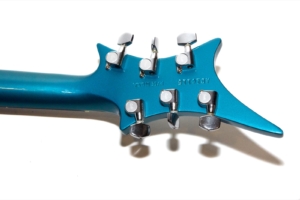 The hardware on the Guild X79 are pretty much what you’d expect if you’ve ever owned a ’70s or ’80s Guild electric guitar. The tuners are nice Schaller mini-tuners. I did have some trouble keeping the guitar in tune, but it could probably have settled a bit more when I got it as I was too eager to put it through its paces. Plus, I try not to blame the tuners until I do a couple of string swaps and make sure the nut and bridge are up to snuff.
The hardware on the Guild X79 are pretty much what you’d expect if you’ve ever owned a ’70s or ’80s Guild electric guitar. The tuners are nice Schaller mini-tuners. I did have some trouble keeping the guitar in tune, but it could probably have settled a bit more when I got it as I was too eager to put it through its paces. Plus, I try not to blame the tuners until I do a couple of string swaps and make sure the nut and bridge are up to snuff.
The strap pegs are typical, though the front one is actually on the back of the guitar up near the tip of the horn. This makes the strap lay flat against the back of the guitar as opposed to being perpendicular to the body of the guitar as it would be if the peg was on the tip of the horn, but I imagine that designers worried about the stress induced on the very long thin horn if they drilled a hole and hung the (admittedly very light) weight of the guitar on that point. Well, half the weight, but you get the idea.
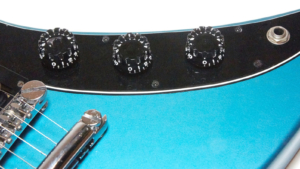 The tailpiece is an SP-6 and the bridge is a Guild Adjusto-Matic made by Mueller. Both are top quality and what I’d expect on a Guild electric from this era. The knobs are notched speed knob style which are quite common on ’80s Guilds. One of the few flaws in this particular guitar is that one of the knobs has a stress crack inside it which is visible in some of the pictures. I’ve seen examples with Guild G-shield knobs such as this 1984-guild-x-79-skyhawk that I found over on Reverb from Emerald City Guitars. Note the added mini-toggle for coil split on that guitar.
The tailpiece is an SP-6 and the bridge is a Guild Adjusto-Matic made by Mueller. Both are top quality and what I’d expect on a Guild electric from this era. The knobs are notched speed knob style which are quite common on ’80s Guilds. One of the few flaws in this particular guitar is that one of the knobs has a stress crack inside it which is visible in some of the pictures. I’ve seen examples with Guild G-shield knobs such as this 1984-guild-x-79-skyhawk that I found over on Reverb from Emerald City Guitars. Note the added mini-toggle for coil split on that guitar.
The pickup selector is in a little bit of an awkward position due to the shape of the body. Since it’s about as far forward as it can go there aren’t many options for other placement given the guitar’s design, but I found that it got in my way a couple of times. I think this has more to do with the guitar’s geometry than the absolute position of the switch, but I’ll cover that more in the playability section. Note that there are other layouts sometimes seen on these guitars as covered in the Electronics section above.
Sound
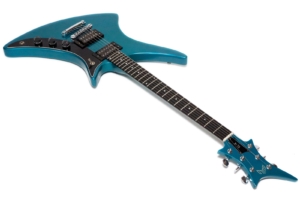 This guitar has definitely got its own thing going on in the looks department, but how does it sound?
This guitar has definitely got its own thing going on in the looks department, but how does it sound?
The first thing I noticed is that this guitar has great sustain. That sort of surprised me because I generally expect heavier guitars to sustain well, but this guitar weighs not even six and a half pounds and sustains with the best of ’em. Guild even references that fact in that in their catalog where they quote Guitar World magazine as saying, …with a lightweight guitar there’s usually a loss of sustain, but the X79 appears oblivious to that fact.
This is an aggressive sounding guitar that’s a bit dark for my tastes, a fact that I attribute to the Guild XR7 pickups and the mahogany body.
[dropshadowbox align=”right” effect=”raised” width=”” height=”” background_color=”#ffffff” border_width=”1″ border_color=”#dddddd” ]ODS100 Clean
7th Chords
Open Chords #1
Open Chords #2
JCM-800
A Barre Chords
D-Shape
Citrus
D-Shape
Marshal 100W Treble
Wanna Rock
[/dropshadowbox]As usual, for these recordings I used my normal Axe-FX II XL+ setup through the QSC K12 speaker recorded direct into my Macbook Pro using Audacity. I recorded using the ODS100 Clean patch, as well as the JCM-800 and one through a setting called Citrus which is a replication of the Orange Rockverb 50 and has become the “I wish it was still the ’80s” setting I like so much. Finally I added the opening chords from Twisted Sister’s I Wanna Rock through the Marshal 100W Treble setting which sounded much better through the amp set to “painfully loud” while no one was home than it does on the recording. That last recording was done on the bridge pickup with the volume rolled of just a bit because the pickups are too hot for my tastes.
For each recording I cycle through the neck pickup, both pickups, and finally the bridge pickup. All knobs on the guitar are on 10 at all times except where otherwise indicated.
The bridge pickup can get a little nasaly for my tastes, and while the guitar is a whole lot of fun to look at, I didn’t find myself inspired by the tone. That could very well be because I’m seriously spoiled and have some of the best solid-body guitars Guild ever made, so take that with a grain of salt because the guitar doesn’t sound bad—it just doesn’t sound great to my ears. If the body is mahogany that could explain part of it because it would behave kind of like an SG, and to my ears a guitar like an SG (or a Guild S100) does much better with brighter more jangly pickups and I think some low wind PAFs would go a long way to making me like the tone of this guitar more. I’ve seen a couple over the hears with Guild HB1 pickups and I think that would be a monster combination.
I’ve said in the past that I had been pleasantly surprised by the Guild XR7 pickups in my 1981 Guild M80, but then I was also dissapointed by them in my 1982 Guild S275, so clearly each guitar is different. I should point out that those had different versions of the XR7 pickups, though I have my doubts if that really matters as much as the body composition does. Regardless of the details, I feel that this X79 would do much better with some high-end sparkle.
Playability
This guitar is a little bit neck heavy and I found that it would slide down a bit when using my El Dorado strap. This is not as severe as the neck-diving SG I used to own, but there’s definitely a bit of a balance issue given the way its built.
The guitar feels… odd when standing, probably due to the radically different shape. I also think the guitar feels very small in my hands and I think that has a lot to do with the body shape as well. Most guitars have more meat behind the tailpiece, and as a result this guitar sits more to the right when holding it than I’m used to. While not a huge deal, the odd geometry of the guitar means that things like palm muting and picking techniques where thrown just a bit off for me. With the guitar sitting differently, the fretboard seemed shorter as well as the entire instrument seems to reside a couple of inches to the right of where I thought it should be.
I found that the huge upper horn visually blocks the fret markers all the way down from the neck joint to the 12th fret which was a bit of an eye-opener when I went to use that entire half of the fretboard, but then you shouldn’t be looking at the fretboard when you play, anyway. Access to the higher registers is quite easy, again due to the nature of the body shape, and with the neck joint being so low-profile, the guitar is very easy to play all the way to the 24th fret.
Conclusion
In the review for the X79-3 I wrote, I dig it, but if I was lusting after this body shape I would wait for a dual-humbucker X79. After owning this and the X79-3 I think my honest impression is that these guitars are kind of an exercise in form over function. They’re very cool to look at, and they play well enough, but I think for me the ergonomics don’t work terrifically well, at least for me. To be fair they may be amazing for someone who isn’t six feet tall and hauling around a couple (OK, a few) extra pounds.
I think the tones produced from the X79 pickups are a little bland for my tastes and the guitar would benefit greatly from a set of nicer coils. A lot of that could be dialed out with EQ and I think lowering the pickups would help to diminish a bit of the guitar’s overbearing oomph which is delivered at the expense of character and articulation. Still, if oomph is what you’re after, this guitar delivers it, and it delivers it with a style that you’d be hard-pressed to find in any other guitar.
I don’t think I’d recommend an X79 as an only guitar. If you’re playing in an ’80s cover band I think it’s got the right look and there’s really nothing terribly wrong with the guitar – It’s just not an awe-inspiring instrument like some of my other ’80s shredders and putting this up against one of my Jacksons the X79 doesn’t stand a chance. My favorite Jackson also weighs 8 lbs 12 oz (3.96 kilos) so that’s not really a fair comparison.
Still, this guitar has a presence, and it looks very cool. It’s very well made, super light, and sustains forever, and with the exception of the pickups which I’d probably replace, the guitar plays great.
The catalog says: The X79 is designed for the musician who’s tired of looking and sounding like everyone else. If that’s the way you’ve been feeling, this instrument was made for you. While I don’t agree with the sound aspect of that statement, when it comes to looks, this guitar is in a league of its own and, honestly, my complaints about this guitar stem from it not behaving like other guitars that I love. That’s kind of the point of the Guild X79: it’s different. Thus me complaining about it being so different is dumb.
The player that chooses this guitar will revel unabashed in its uniqueness. To that end, this guitar is an absolute winner.
Donate: PayPal Crypto:
ETH: 0x0AC57f8e0A49dc06Ed4f7926d169342ec4FCd461
Doge: DFWpLqMr6QF67t4wRzvTtNd8UDwjGTQBGs

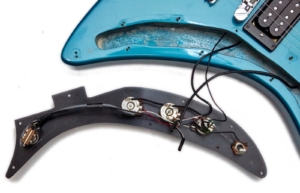
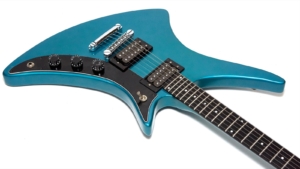
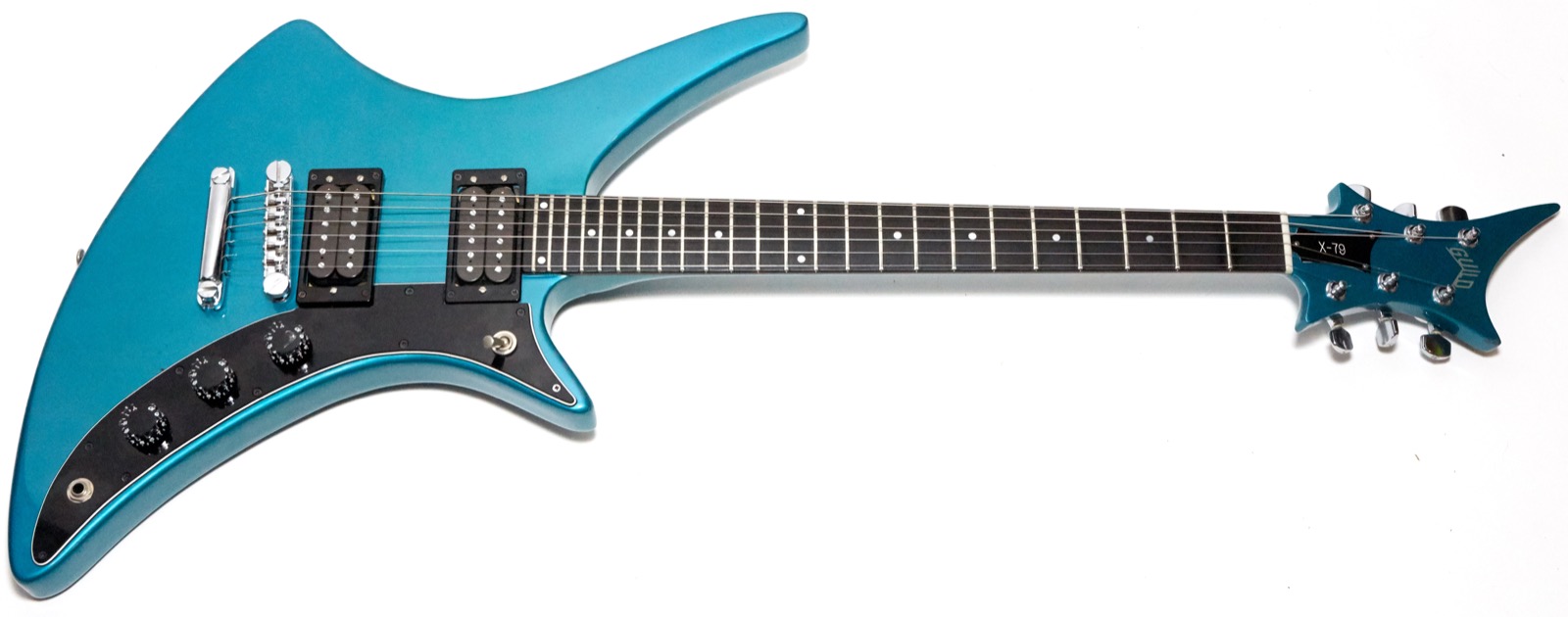
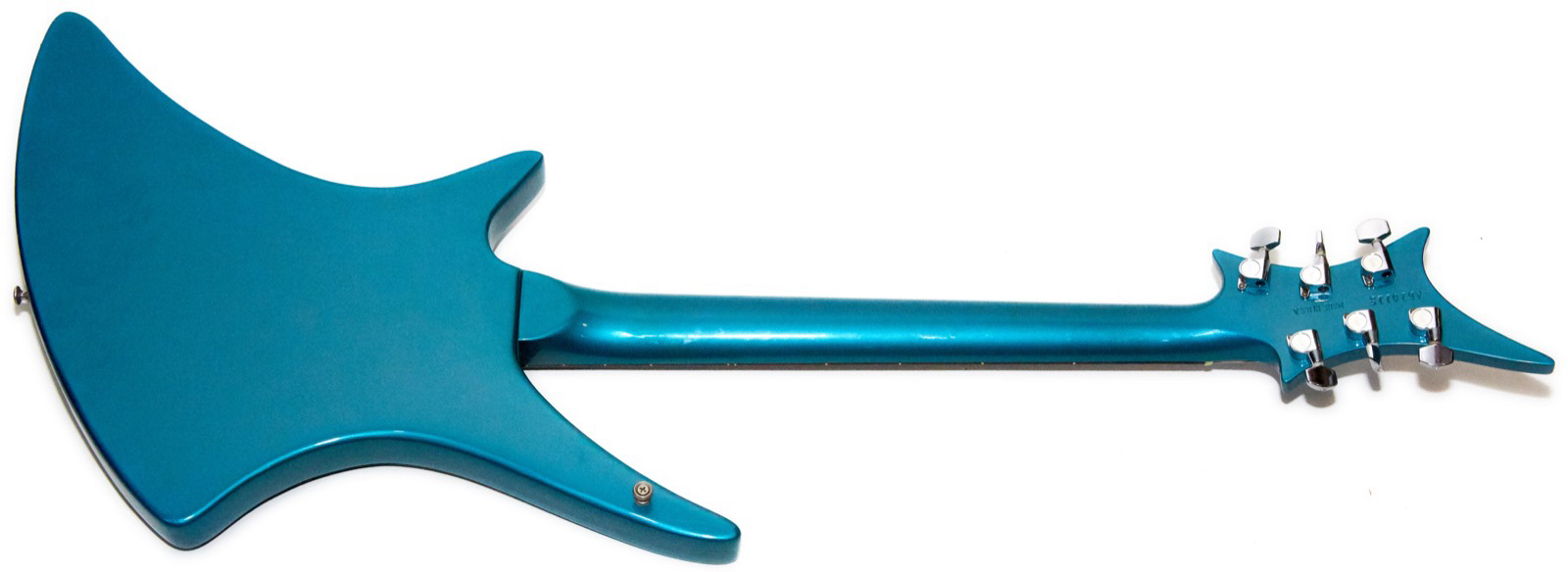
You are correct about the finish being Lacquer. I used to work in the finishing department at Guild in Westerly. In fact I am the one that took the design that was submitted to us by JJ French and applied it to the x79’s body. I put almost all of the graphics on the guilds until I left the company for a short time in 1984.
The candy apple red probably flaked off the worst out of all the finishes due to the fact that they used real metal flake under the finish. It created a heck of a static electric discharge when the guitar was buffed that really hurt and sometimes damaged the finish. I wouldn’t be surprised to find the cause of the finish popping loose was due to the sparks that would be felt when polishing the finish.
Wow… Paul, my firend, do you have, by any chance, a tracing od the x-79 body? Im looking to buil one with a spare neck I hace and cant find a tracing or a template anywhere.
Congratulations of your job at Guil, you made great guitars!
Cheers!
Sorry for the orthographic mistakes, beer 🙂 .
I had a sunburst X79 in the 80s, so it couldn’t have been a custom job. I got it at a little guitar shop in NJ. I remember the frets on that guitar being beyond jumbo. My guitar teacher called them “dressed” frets, and he said they were good for practicing because it made me extra precise. You’re also right about the lightness. My next guitar was a Les Paul and it was like going from a golf ball to a bowling ball.
I had no idea the fretboard was ebony!
I sold mine years ago and I have no idea where it is now.
I bought a red x-79 in 1984 for $378.00. Grabbed it off the wall and fell in love with the feel of it. Done nothing to it but strings .Left it outside one night in the shed , freezing cold,and the finish cracked everywhere on the guitar. Used and abused, it still plays beautifully.Love this thing! 1-11-2019 doug m.
I always thought the Khaler on mine was aftermarket because I had never seen one. Would love to shoot you a pic. Maybe you can tell me whether it’s original or not. I’m still not convinced…ha.
Sure! Feel free to email me at gad@gad.net.
I have owned four X79s. My first Guild was an S70D and totally love it. I played it on the road for years. Then I bought a new X79 twisted sister . It was stole from me and I was devastated. I found a blue one at the same store but it’s not the blue one in your pictures. My third one is like the blue one in the picture. And yesterday I bought a black sparkle. Thank you for all the information you put out
Do you by any chance have the traciong or template for the body of this x-79? Im looking for building its body for a neck I have and cant find it anywhere!!
I hope you can help me.
Cheers,
Fernando from Buenos Aires
Sorry – can’t help you there.
Ferando, I did a full engineering drawing for an X-79 body, neck with a 628mm/24F fingerboard, and more standard parts. We were considering making these for awhile… before my shop burned down in 2007. If you’d like a copy email me at mirageguitarworks@yahoo.com.
I asume that you don’t have AutoCAD or anything that’ll open a CAD file so I can make and send a print.
Hello Paul, would you please share your drawings with me? I’m awaiting the arrival of an instrument that I’ve purchased to restore, but need the pickup ring dimensions and information because they are missing.
Absolutely right on the pickups. I had a black sparkle X79 I ended up ditching because the pickups were a bit dark for what I do.
I did NOT, however, get rid of the refinished red Skyhawk I got for $225 in 1990. Someone had put some crazy Carvin humbuckers in the thing, but it was otherwise intact.
I put an old gold-plated 60’s Firebird pickup in the neck, a Duncan Cool Rails in the middle (this was going to be a Gretsch DeArmond pickup originally, but it turned out the pickup was dead). One full-size humbucker in the back, and it was ready to be wired.
I moved the volume control where the pickup switch used to be, added individual tone push/pulls and on/offs for each pickup. The rear two tones pulls split the rear two pickups, and the front tone pull flips the phase of the middle pickup. Oh, and I also added a Bigsby.
This sounds ridiculous, but no one who’s ever heard it will argue about how good it sounds. I heard an entire universe hiding behind those Carvins and DiMarzios, and I was not disappointed in the least! It’s a surf/psych monster and a snarling fuzz beast with all the jangle and sparkle you can get, and it shimmers like crazy. It does NOT sound like anything else, and it isn’t just my pickup choices, which aren’t especially odd.
My point is that I have plumbed the depths of the tonal variety these beasts are capable of, and there is a whole word in there waiting for those bold enough to find the right pickups.
I’ve been playing that guitar since 1990, and I expect to be buried with it.
I should also add that I’m pretty sure there’s at least one white x-79-3 with an ash body. I played it often in a guitar store in 2000, but never got up the scratch to get it. It had a mahogany neck and an ebony fretboard; and, as far as we could tell, the body seemed to be ash.
Now that’s something I’d love to see. That would have to have been a one-off or custom order.
Hi,
I received an X-79 Ltd in beautiful teal with a paler,almost white center. I can’t seem to find anything about about tbe Ltd version. Can you give me some info pls?
Can you send me a pic?
My favorite
Bought it in a pawn shop in 85
Lightest fastest thing I ever played with sustain un obtained any where else
I miss it dearly
AJ
There was a Guild rep by the name of Joe Gentle who came into my shop and offered to sell me all the remaining X-79’s (by this time the controls were rear mounted) and the front of the body was contoured for the right arm ala Strat. There were also a number of X-100 Bladerunners in the deal. I bought 4 of the X-79’s for $200 each with cases. Oh well.
We have been seriously considering building a short run of X-79’s but haven’t moved far enough along to see how much interest there is.
I have full engineering drawings I took right from a guitar then did some modification to be able to use more readily-available components. If I did build there would certainly be a possibility of special colors and parts.
Of course, it wouldn’t say Guild on the headstock.
Hey Gary,
Do you still own the guitar from this review? I used to own this same guitar (X-79, metallic blue) and sold it about 20 years ago. Have been interested to buy it back for old times’ sake. Let me know if you still own it and would be open to selling it?
I do not. You will be very hard-pressed to find one that still looks blue. Any X79 you see for sale that’s green was originally blue and the clear-coat has yellowed over time.
I am 5 foot 2 and have small hands. I loved playing my X-79 when I was in bands in the late 80’s and early 90’s, but by that time the guitar was looking a bit out dated and the music I played was rock and roll, not metal. I switched over to a standard Fender Squire and then a Strat, but nothing has ever played as easily as the X-79. I loved the weight, the sustain and that neck and fretboard with low action. Is there anything out there in the guitar world that has a comparable neck?
I own that Guild x79 Skyhawk bumblebee guitar. Bought it in a guitar store in Mpls. run by a friend of the Stryper band. I bought it late 2000’s… It’s been my main guitar in my band Venus de Mars & All The Pretty Horses for years. Direct link to a photo of my band, and me, taken in 2022 in link below.
https://www.venusdemars.com/278440988_10159954063628953_5729785091606769937_n.jpg